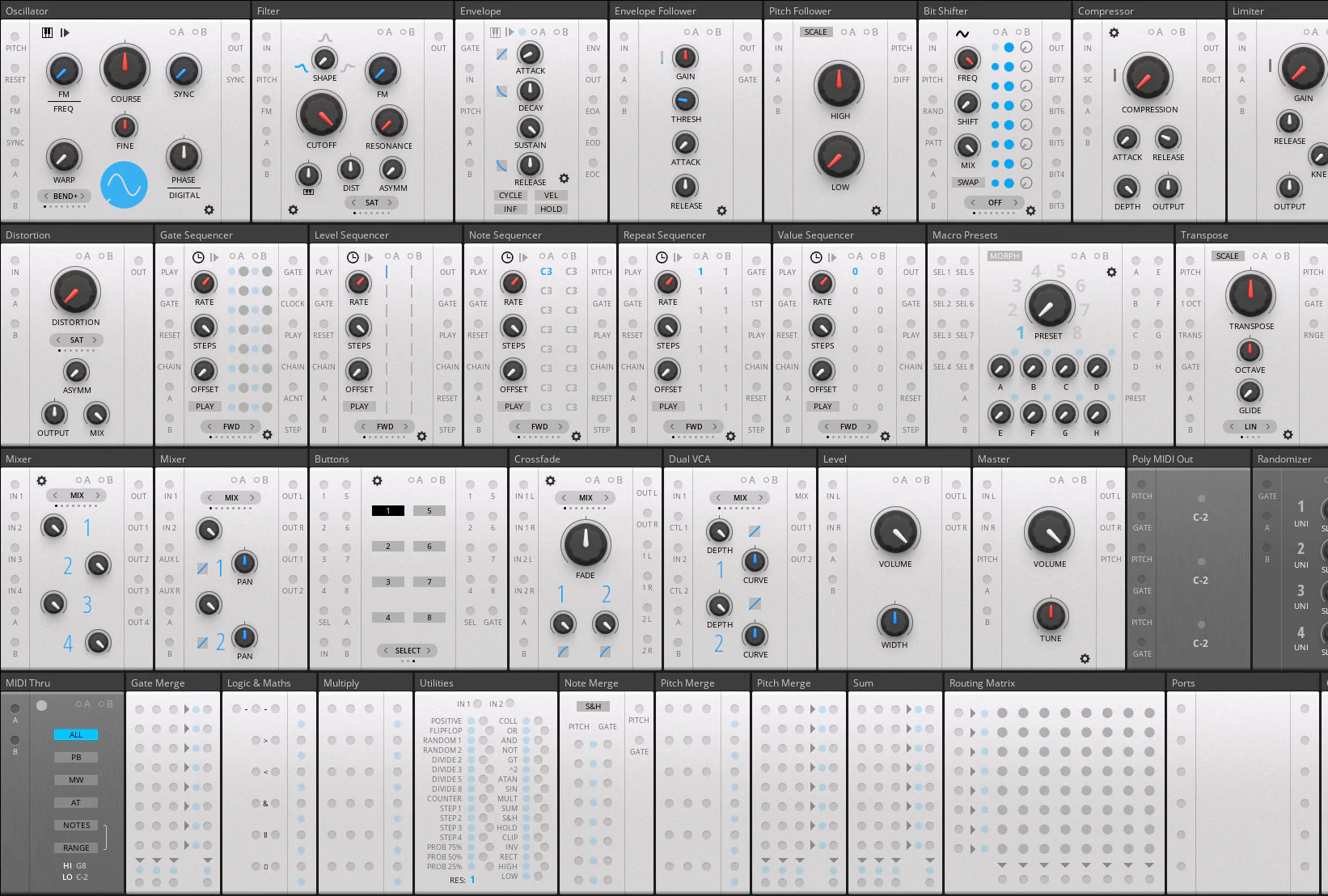
The Free Pack includes all the essential blocks needed for creative sound design including 5 powerful sequencer blocks, sophisticated multi-wave oscillators with multiple warping modes and a suite of versatile utilities. The pack is FREE to download and can also be used without limitations with the free Reaktor Player.
Included modules:
Oscillators
- Oscillator
- Mini Oscillator
- Drums
Filters
- Filter
- Filter (Stereo)
- Mini Filter
- Mini Filter (Stereo)
Effects
- Compressor
- Limiter
- Distortion
- Bit Shifter
- Compressor (Stereo)
- Limiter (Stereo)
- Distortion (Stereo)
- Bit Shifter (Stereo)
Modulation
- Envelope
- Envelope Follower
- Pitch Follower
Sequencers
- Gate Sequencer
- Note Sequencer
- Value Sequencer
- Level Sequencer
- Repeat Sequencer
- Gate Sequencer 32
- Note Sequencer 32
- Value Sequencer 32
- Level Sequencer 32
- Position
- Position Sequencer 32
Utility
- 4 Ch Mixer (Stereo)
- Mixer (Stereo)
- 4 Ch Mixer
- Mixer
- Level
- Master
- Macro Presets
- Multiply
- Randomizer
- Routing Matrix
- Buttons
- Sum
- Transpose
- Utilities
- Logic & Maths
- Note Merge
- Gate Merge
- Pitch Merge
- Crossfade
- Buttons
- Dual VCA
- MIDI Thru
- Poly MIDI Out
- OSC Send
- OSC Receive
- Short Delay
Oscillator

A versatile oscillator that can be used either as an audio rate oscillator or as an LFO.
Features a ‚Warp‘ control that bends the waveform in 8 ways:
- BEND + = Bends the waveform to one side.
- BEND – = Bends the waveform out towards the edges.
- ASYM (Asymmetry) = Squishes the waveform from the middle to the edge in a linear fashion for ‚Pulse Width Modulation‘ style effects.
- SYNC = Duplicates the the waveform a number of times, simulating the ’sync‘ function found on older analogue synthesisers.
- HYPER = Warps the waveform in an aggressive fashion.
- FOLD (wave-folding) = The waveform acts like a wave-shaper to transform a sine wave. Can be used to create very bright / complex sounds with lots of harmonics.
- WRAP = The waveform is stretched vertically and wrapped back down creating multiple jagged folds.
- RAND = Generates random values (noise). The ‚WARP‘ control sets the transition slope between values (fully anticlockwise = stepped transitions). The random signal output is ’shaped‘ according to the setting of the ‚WAVE‘ control. The ‚COARSE / FREQ / LENGTH‘ knob sets the frequency of the randomly generated values. With these controls a wide selection of random signals and colours of noise can be generated. Set ‚SYNCHRONISATION MODE‘ to ‚FREE‘ and the ‚FREQ‘ knob to maximum to generate white noise.
The oscillator also features 3 synchronisation modes:
- FREE (wave icon) = The pitch of the oscillator can be set freely with no synchronisation.
- KEY TRACK (keyboard icon) = You can control the pitch of the oscillator via the Pitch input.
- CLOCK (clock Icon) = The speed of the oscillator is synchronised with the master tempo.
Mini Oscillator

A simple oscillator that can be used either as an audio rate oscillator or as an LFO.
Features a ‚Warp‘ control that bends the waveform in 7 ways:
- BEND+ = Bends the waveform to one side.
- BEND- = Bends the waveform out towards the edges.
- ASYM (Asymmetry) = Squishes the waveform from the middle to the edge in a linear fashion for ‚Pulse Width Modulation‘ style effects.
- SYNC = Duplicates the the waveform a number of times, simulating the ’sync‘ function found on older analogue synthesisers.
- HYPER = Warps the waveform in an aggressive fashion.
- FOLD (wave-folding) = The waveform acts like a wave-shaper to transform a sine wave. Can be used to create very bright / complex sounds with lots of harmonics.
- WRAP = The waveform is stretched vertically and wrapped back down creating multiple jagged folds.
Features 3 synchronisation modes:
- FREE (wave icon) = The pitch of the oscillator can be set freely with no synchronisation.
- KEY TRACK (keyboard icon) = You can control the pitch of the oscillator via the Pitch input.
- CLOCK (clock Icon) = The speed of the oscillator is synchronised with the master tempo.
Drums
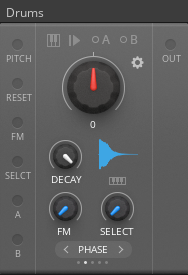
A simple drum sample player with 120 preloaded drum samples.
When the ‚MAP‘ button (small keyboard icon) is enabled the samples are mapped across the keyboard and selected by the pitch input.
The ‚FM MODE‘ control selects one of 5 FM Modes:
- FREQ = The FM input modulates the pitch of the sample, the FM knob sets the amount of modulation.
- PHASE = The FM input modulates the phase (playback position) of the sample, the FM knob sets the amount of modulation.
- PHASE 2 = Same as PHASE 1 but the FM input signal is offset.
- SCRATCH = The FM knob plays through the sample like a record being scratched, the FM input is ignored.
- DIRECT DRIVE = The value of the FM input, between 0 and 1, offsets the playback position across the whole length of the sample, the FM knob sets the amount of offset.
Filter
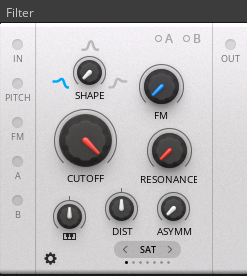
A clean punchy filter with a ‚zero feedback delay‘ design (a more accurate way of modelling the feedback path of an analog filter where no delay is introduced to the feedback path).
The filter features pre or post filter saturation with 7 styles of distortion:
- SAT = low aliasing simulation of analog saturation.
- SINE = sine-wave shaped ‚wave-folding‘ distortion with lots of tone.
- SINE X10 = extreme ‚wave-folding‘ style distortion.
- KINKY = triangle shaped wave-folding.
- DRIVE = low aliasing simulation of an overdrive pedal.
- ATAN = A simple saturation curve.
- CLIP = hard clipping.
Turning the distortion control to the left increases pre-filter distortion, turning it to the right increases post-filter distortion. When the distortion control is set in the central position the saturation stage is bypassed.
Includes mono and stereo versions. The stereo version has a ‚STEREO A/B MODULATION‘ switch on the ‚Options‘ panel. When this is enabled the A/B modulation is split up: A only affects the left channel and B only affect the right channel allowing independent modulation of each channel.
Mini Filter

A simple filter using a low CPU ‚zero feedback delay‘ design (a more accurate way of modelling the feedback path of an analog filter where no delay is introduced to the feedback path).
Compressor


A versatile compressor with 5 modes of operation: Peak, RMS & 3 Opto modes (simulates the detection circuit of optical style compressors). With configurable circuit topology (feedback, feed-forward, saturation etc) and 3 different knee options a variety of compression tones can be achieved.
A separate side-chain input allows for versatile side-chain processing options and the ‚Reduction‘ output port can be used to send out a signal corresponding to the compression action that can be used to modulate other modules, for example: connecting the ‚Reduction‘ port to modulate the gain of the ‚Peak EQ‘ block to create a dynamic equaliser.
Includes mono and stereo versions.
Limiter

A brick-wall limiter with controls for knee shape, release time and side-chain high-pass filter cutoff. Includes mono and stereo versions.
Distortion

A powerful distortion processor with 6 styles of distortion:
- SAT = low aliasing simulation of analog saturation.
- SINE = sine-wave shaped wave-folding distortion with lots of tone.
- SINE X10 = extreme wave-folding style distortion.
- KINKY = triangle shaped wave-folding.
- DRIVE = low aliasing simulation of an overdrive pedal.
- CLIP = hard clipping.
Includes mono and stereo versions.
Bit Shifter


An 8 bit distortion effect with controls to shift, offset (delay), enable and disable each of the 8 digital ‚bits‘.
Bit switches:
Click on the switches to turn on or off each bit. Click and drag to turn on or off multiple switches. Right-click to clear all the switches. Double-click on a switch to invert that bit. Double-click and then drag to invert multiple bits.
Filter presets:
Select from 8 presets for the pre and post filters and analog saturation stages.
Envelope


A versatile ADSR (attack, decay, sustain release) style envelope with individual shape controls for each stage. The cycle switch causes the the envelope to cycle back to the start, making it behave like an LFO or oscillator. When the hold switch is enabled the envelope stays open until all stages have finished and note offs are ignored. The envelope also features controls on the options page to set the start and end level for the attack stage for more flexibility. The ‚In‘ and ‚Out‘ ports are connected to an amplifier inside the block that is controlled by the envelope so it isn’t necessary to use a separate VCA (voltage controlled amplifier) to control signals.
Envelope Follower

Follows the level of the signal at the ‚In‘ port and then outputs an equivalent modulation signal at the ‚Out‘ port. Also features a ‚Gate‘ output port to enable the follower to trigger other blocks (envelopes, samples, sequences etc) when the signal at the input exceeds the threshold set by the ‚Gate Threshold‘ control. The ‚Options‘ page includes a DETECTOR MODE control that selects between 5 different modes of operation: Peak, RMS & 3 Opto modes (simulates the detection circuit of optical style compressors) plus controls for the side-chain high-pass filter, hold time and a hysteresis control (reduces rapid ‚chattering‘ of the gate signal, with the gate turning on and off rapidly with fluctuations of the level of the follower).
Pitch Follower


Follows the pitch of the signal at the ‚In‘ port and then outputs an equivalent pitch signal at the ‚Pitch‘ output port. The High and Low controls set the frequency range of the pitch detection. Use these controls to tune the follower to the range of notes in the signal that you wish to follow. A scale button applies ‚autotune‘ style pitch snapping to the output. Settings for Scale and key are on the options page (hidden feature: double click on ‚SCALE / TUNING‘ to open a panel where the notes of the scale can be edited).
Also features a ‚Difference‘ output port that outputs a signal equivalent to the difference between the corrected and un-corrected pitch signals, use this output to control a pitch shifter block for an auto-tune stye effect.
Gate Sequencer

A versatile 16 step gate sequencer with a built-in clock generator.
Click on the step switches to turn on or off the sequencer steps. Click and drag to turn on or off multiple switches. Right click to clear all the switches. Double click on a switch to assign that switch to the ‚Accent‘ output.
Click on the ‘MANUAL GATE’ button when the sequencer is playing to record steps in real time.
Chaining:
Use the ‚Chain Input‘ and ‚Chain Output‘ ports to daisy-chain multiple instances of the Gate Sequencer block together to create sequences of any length.
A positive signal at the ‚Chain Input‘ port causes the sequence to play once. When the sequence reaches the last step it sends a positive signal from the ‚Chain Output‘ port, causing the next block in the chain to play.
Connect the ‚Chain Output‘ port of the last block in the chain back to the ‚Chain Input‘ port of the first block in the chain (creating a loop) to have the whole sequence loop continuously.
A negative signal at the ‚Chain Input‘ port causes the sequencer block to stop playback and then pass this negative ’stop‘ signal on to its ‚Chain Output‘ port thus also stopping all other blocks further down the chain (A negative signal is sent from the ‚Chain Output‘ port when the sequencer is manually stopped, so all blocks in the chain stop together).
There are controls on the options page to enable MIDI control (allowing MIDI notes on a hardware sequencer to switch on and off individual steps) as well as swing, length and jitter controls.
The ‚STEP MODE‘ control sets the mode and direction of movement of the sequencer. The following modes are available:
- FWD (forward) = The sequence plays forwards.
- REV (reverse) = The sequence is reversed.
- FWD-REV (forward then reverse) = The sequence plays forwards and then backwards, for example: 1,2,3,4,4,3,2,1,1,2,3,4 etc.
- TRI (triangle) = Same as FWD-REV but adds an extra step at the end so that the first and last steps aren’t repeated, for example: 1,2,3,4,5,4,3,2,1,2,3,4,5 etc.
- PATT 1 (pattern 1) = Plays back the sequence using a pattern.
- PATT 2 (pattern 2) = Plays back the sequence using a different pattern.
- RAND (random) = Plays back the steps randomly.
- GLITCH = Same as FWD except every so often plays a random step.
The swing, jitter and delay controls are applied to the signals connected to the gate input as well as the internal clock so that the block can be used as a gate processor.
The PATTERN CONTROL‘ selects 1 of 8 patterns to play and edit. Hidden feature: there is a hidden shortcut to this control on the front panel that is revealed by hovering over the bottom left corner of the panel (so you don’t need to visit the options page to change presets). Drag the number to select the preset, double-click the number to copy the current preset to the next preset number and right-click to randomise the current preset.
Note Sequencer

A 16 step note sequencer with built-in clock generator.
Note switches: Drag on the note names to set the note pitch for that step, double-click to mute it, right-click or right-click and drag to audition the pitch. Right-click and hold and then play a MIDI note to set the pitch of that step via MIDI. Use the ‚GLIDE UP‘ and ‚ GLIDE DOWN‘ controls (on the options page) to create smooth transitions (pitch glides) between steps, a value of 25 gives a linear transition lasting the length of the step. Trigger the sequencer from the ‚CHAIN‘ input port to have it only play once.
Value Sequencer

A 16 step value sequencer with built-in clock generator.
Value switches: Drag on the values numbers to set the value for that step between 0 and 100, double-click to mute it, right-click or right-click and drag to audition the value.
As well as functioning as a step sequencer you can also use the Value Sequencer to generate custom envelope and LFO shapes, use the ‚GLIDE UP‘ and ‚ GLIDE DOWN‘ controls (on the options page) to create smooth transitions between steps, a value of 25 gives a linear transition lasting the length of the step. Trigger the sequencer from the ‚CHAIN‘ input port to have it only play once like an envelope.
Level Sequencer

A 16 step level sequencer with built-in clock generator.
Level Faders:
Drag on the level fader to set the value for that step, double-click to mute it, right-click and drag to finely adjust the value. Click and drag up and down across the faders to set multiple values in one go.
There are controls on the options page for swing, length and jitter as well as controls to control the ‚gliding‘ of the values between steps.As well as functioning as a step sequencer you can also use the Value Sequencer to generate custom envelope and LFO shapes, use the ‚GLIDE UP‘ and ‚ GLIDE DOWN‘ controls (on the options page) to create smooth transitions between steps, a value of 25 gives a linear transition lasting the length of the step.
Gate Probability Mode:
When ‚GATE PROBABILITY MODE‘ (on the options page) is enabled the probability that a gate signal will output from the gate output port is determined by the level of the current step. If the level is at 0% then a gate will never be outputted, If the level is at 100% then a gate will always be outputted, If the level is at 50% then a gate will be outputted with a 50% probability.
Gate Sequencer 32

A 32 step gate sequencer.
Step switches:
Click on the switches to turn on or off the sequencer steps. Click and drag to turn on or off multiple switches. Right click to clear all the switches. Double click on a switch to assign that switch to the ‚Accent‘ output.
There are controls on the options page to enable MIDI control (allowing MIDI notes on a hardware keyboard to switch on and off individual steps) as well as swing, length and jitter controls.
Accent Output: Double click on a step and it will be outputted from the accent output port.

A 32 step note sequencer.
Note switches:
Drag on the note names to set the note pitch for that step, double-click to mute it, right-click or right-click and drag to audition the pitch. Right-click and hold and then play a MIDI note to set the pitch of that step via MIDI.
There are controls on the options page for swing, length and jitter as well as controls to control the ‚gliding‘ of the pitch between steps.
The step mode control sets the mode and direction of movement of the sequencer. The following modes are available:
- FWD (forward) = the sequence plays forwards.
- REV (reverse) = the sequence is reversed.
- FWD-REV (forward then reverse) = the sequence plays forwards and then backwards, for example: 1,2,3,4,4,3,2,1,1,2,3,4 etc.
- TRI (triangle) = Same as FWD-REV but adds an extra step at the end so that the first and last steps aren’t repeated, for example: 1,2,3,4,5,4,3,2,1,2,3,4,5 etc.
- PATT 1 (pattern 1) = Plays back the sequence using a pattern.
- PATT 2 (pattern 2) = Plays back the sequence using a different pattern.
- RAND (random) = Plays back the steps randomly.
- GLITCH = Same as FWD except every so often plays a random step.
Value Sequencer 32

A 32 step value sequencer.
Value switches:
Drag on the values numbers to set the value for that step between 0 and 100, double-click to mute it, right-click or right-click and drag to audition the value.
There are controls on the options page for swing, length and jitter as well as controls to control the ‚gliding‘ of the values between steps.As well as functioning as a step sequencer you can also use the Value Sequencer to generate custom envelope and LFO shapes, use the ‚GLIDE UP‘ and ‚ GLIDE DOWN‘ controls (on the options page) to create smooth transitions between steps, a value of 25 gives a linear transition lasting the length of the step.
Level Sequencer 32

A 32 step level sequencer.
Level Faders
Drag on the level fader to set the value for that step, double-click to mute it, right-click and drag to finely adjust the value. Click and drag up and down across the faders to set multiple values in 1 go.
There are controls on the options page for swing, length and jitter as well as controls to control the ‚gliding‘ of the values between steps.As well as functioning as a step sequencer you can also use the Value Sequencer to generate custom envelope and LFO shapes, use the ‚GLIDE UP‘ and ‚ GLIDE DOWN‘ controls (on the options page) to create smooth transitions between steps, a value of 25 gives a linear transition lasting the length of the step.

A 16 step step-repeating sequencer with built-in clock generator.
Repeat count controls:
These controls set the number of clocks repeated for each step. Drag on the numbers to set the number of repeats for that step between 1 and 100, double-click to mute or hold the step (the mode of the MUTE / HOLD state is set by the MUTE / HOLD MODE control on the options page.
The „MUTE / HOLD MODE“ sets the mode of the MUTE/HOLD state (double click on a step to enable the MUTE/HOLD state):
- MUTE = The step is muted.
- SINGLE = A single gate plays with the first gate of the step.
- REPEAT = Plays all the gates repeatedly for the duration of the step.
- HOLD = The gate is held for the duration of all the repeats in the step.
- TIE = The gate is held for the duration of the entire step and held over to the following step.
Position

Drives the POSITION input of the sequencer blocks. The block divides a phase CYCLE (for example a ramp signal from an LFO or the internal cycle generator) into a set of smaller STEPS which are then further divided into SUBS STEPS. There are controls to repeat, multiply, divide and manipulate the steps and sub steps.
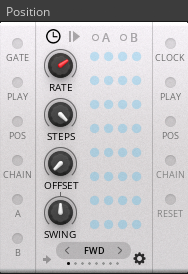
A 32 step position sequencer with built-in clock generator.
Chaining:
Use the ‚Chain Input‘ and output ports to daisy-chain multiple instances of the Gate Sequencer block together to create sequences of any length.
A positive signal at the ‚Chain Input‘ port causes the sequence to play once. When the sequence reaches the last step it sends a positive signal from the ‚Chain Output‘ port, causing the next block in the chain to play.
Connect the ‚Chain Output‘ port of the last block in the chain back to the ‚Chain Input‘ of the first block in the chain (creating a loop) to have the whole sequence loop continuously.
A negative signal at the ‚Chain Input‘ port causes the sequencer block to stop playback and then pass this negative ’stop‘ signal on to its ‚Chain Output‘ port thus also stopping all other blocks further down the chain (A negative signal is sent from the ‚Chain Output‘ port when the sequencer is manually stopped, so all blocks in the chain stop together).
Gate Merge

Merges gate signals together.
Pitch Merge

Merges pitch signals together.
Note Merge

Merges pitch and gate signals together. When ‚S&H‘ is enabled the pitch is only updated when there are positive zero crossings at the gate inputs.
Mixer

A 2 channel mixer with pan and gain curve controls. The mixer has 8 modes with which it uses to mix the 2 channels:
- MIX = Normal Mixer.
- RING A = Analog Ring Modulation.
- RING D = Digital Ring Modulation.
- AM A = Analog Amplitude Modulation.
- AM D = Digital Amplitude Modulation.
- S&H = Sample & Hold Method 1 (Hold when modulating signal crosses zero).
- HOLD = Sample & Hold Method 2 (Hold when modulating signal is positive, pass when modulating signal is negative).
- OR = Selects the signal with the most positive amplitude.
Includes mono and stereo versions.
4 Channel Mixer
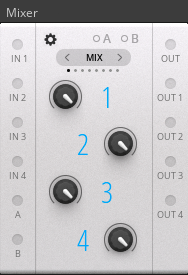
A 4 channel mixer. The mixer has 8 modes with which it uses to mix the channels (the mixing mode is applied to channels 1+2 & 3+4 as 2 separate groups of channels):
There are 8 different modes for the mixer:
- MIX = Normal Mixer.
- RING A = Analog Ring Modulation. Level control 2/4 functions as a dry/wet control.
- RING D = Digital Ring Modulation. Level control 2/4 functions as a dry/wet control.
- AM A = Analog Amplitude Modulation.
- AM D = Digital Amplitude Modulation.
- S&H = Sample & Hold Method 1 (Hold when input 2/4 crosses zero). Level control 2/4 functions as a dry/wet control.
- HOLD = Sample & Hold Method 2 (Hold when input 2/4 is positive, pass when input 2/4 is negative). Level control 2/4 functions as a dry/wet control.
- OR = Selects the signal with the most positive amplitude.
If the individual channel outputs are connected but the channel inputs are disconnected then the outputs will send out a constant value equivalent to the setting of the level control, enabling the level control to be used as a ‚macro‘ control.
Dual VCA

2 Basic VCAs (Voltage Controlled Amplifiers) with controls for depth and modulation shape.
The VCA has 8 modes with which it uses to mix the 2 channels before sending them to the ‚MIX‘ output:
- MIX = Normal Mixer.
- RING A = Analog Ring Modulation.
- RING D = Digital Ring Modulation.
- AM A = Analog Amplitude Modulation.
- AM D = Digital Amplitude Modulation.
- S&H = Sample & Hold Method 1 (Hold when input 2 crosses zero).
- HOLD = Sample & Hold Method 2 (Hold when input 2 is positive, pass when input 2 is negative).
- OR = Selects the signal with the most positive amplitude.
Crossfade

Crossfade allows you to create a blend between two input signals with a single FADE control. For example, it can be used to smoothly morph from one sound to the other, to combine waveform outputs from oscillators for additional wave shaping, or as a simple dry / wet control when routing effect signals
8 mixing modes are available:
- MIX = Normal Mixer.
- RING A = Analog Ring Modulation.
- RING D = Digital Ring Modulation.
- AM A = Analog Amplitude Modulation.
- AM D = Digital Amplitude Modulation.
- S&H = Sample & Hold Method 1 (Hold when modulating signal crosses zero).
- HOLD = Sample & Hold Method 2 (Hold when modulating signal is positive, pass when modulating signal is negative).
- OR = Selects the signal with the most positive amplitude.
Level

A simple stereo level control with a knob to control the stereo width.
Master

Master volume and master tune controls.
Macro Presets
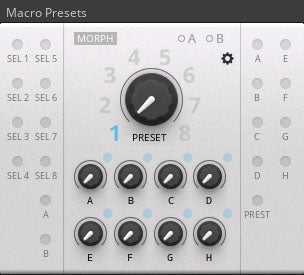
A bank of 8 macro knobs. Different values for each knob can be stored in 8 presets. The presets can be recalled with a knob, via modulation (up to audio rate) or with MIDI. When ‚Morph‘ mode is enable the values are smoothly interpolated between presets. There is a control on the options page to enable MIDI control, allowing the presets to be switched by a range of 8 MIDI notes on a hardware MIDI controller.
The presets can be selected for editing by turning the knob or clicking on one of the numbers. The current preset being edited is shown as a dark grey number. The currently playing preset (selected via modulation or MIDI and being sent to the outputs) is shown as a blue number. The ‚playing‘ preset number (blue) and ‚editing‘ preset number (grey) can be linked or unlinked when selecting presets with midi etc by using the ‚FOLLOW‘ button on options page. Right click a number to change the ‚editing‘ preset while keeping the ‚playing‘ preset the same.
To edit the 5 character label for each knob scroll up and down on the label to select letters, numbers and symbols. Double-click to reset the characters to a blank space.
Buttons

A bank of 8 buttons that can be configured in 1 of 3 modes:
- TRIGGER = 8 Non-latching trigger buttons.
- SWITCH = 8 Latching switches.
- SELECT = 8 Selection buttons, selected button number is sent from the ‚SEL‘ port, sent as 8 values between 0 – 1.
There are editable labels on and below each button (drag up and down to change each character of the label). Right-click on the button to set the button’s colour.
Multiply

Each input port in a row is multiplied with its neighbour. If ports are un-connected they are ignored.
Can be used, for example, to have the modulation wheel of a MIDI controller control the amount of pitch modulation from an LFO. This can be done by multiplying the signals from the mod wheel and LFO together and then sending the result to the oscillator.
Randomizer

4 channel random value generator.
Generates a random value at the output every time a gate signal is received. Values can change instantly or ramp between values, transition time between values is set by the slope control.
Routing Matrix

Click on switches to route inputs to the output. Click and drag to turn on or off multiple switches. Right click to clear the matrix.
Sum

Mixes signals together.
Transpose

Transposes pitch signals. A scale button applies ‚autotune‘ style pitch snapping to the output. Scale and key are set on the options page (hidden feature: double click on ‚SCALE / TUNING‘ to open a panel where the notes of the scale can be edited). The block also has a glide control that causes the pitch signal to slide between notes. The glide function has 4 different modes:
- LIN = Linear glide, constant time to slide between notes.
- OLD = Vintage style glide.
- SKIP = Vintage style glide with a head start.
- RATE = Constant rate glide.
When no cables are connected the pitch input ports an input value of 0.5 (C3) will be used instead, allowing the block to be used as a stand alone pitch-value generator.
Utilities

A Swiss-army knife of 33 different math, logic and gate functions, 2 inputs and 33 outputs.
- POSITIVE = Outputs a gate signal while the signal at input 1 is positive.
- FLIPFLOP = With every gate received at input 1 outputs either 1 or 0 alternating.
- RANDOM 1 = Outputs a random value between 0 & 1 with with every gate received at input 1.
- RANDOM 2 = Outputs a different random value between 0 & 1 with with every gate received at input 1.
- DIVIDE 2 = Clock divider, outputs every other gate received at input 1.
- DIVIDE 3 = Clock divider, outputs every 3rd gate received at input 1.
- DIVIDE 5 = Clock divider, outputs every 5th gate received at input 1.
- DIVIDE 8 = Clock divider, outputs every 8th gate received at input 1.
- COUNTER = Cycles through 4 values with every gate received at input 1: 0, 0.333, 0.666, 1
- STEP 1 = Outputs a gate on the 1st step of the counter.
- STEP 2 = Outputs a gate on the 2nd step of the counter.
- STEP 3 = Outputs a gate on the 3rd step of the counter.
- STEP 4 = Outputs a gate on the 4th step of the counter.
- PROB 75% (probability 75%) = Outputs a gate 75% of the time when a gate is received at input 1.
- PROB 50% (probability 50%) = Outputs a gate 50% of the time when a gate is received at input 1.
- PROB 25% (probability 25%) = Outputs a gate 25% of the time when a gate is received at input 1.
- COLL (collision) = Outputs a gate whenever input 1 is almost the same value as input 2. If only input 1 is connected then outputs a gate whenever input 1 is close to a grid of 120 values between 0 and 1.
- OR = Outputs a gate if either input 1 or input 2 is greater than 0.
- AND = Outputs a gate if only if input 1 and input 2 are both greater than 0.
- NOT = Outputs a gate if input 1 is not greater than 0.
- GT = Outputs a gate if input 1 is not greater input 2.
- ^2 = Values at input 1 are squared (and multiplied input 2 if it’s connected).
- ATAN = Applies an atan function to input 1 (if input 2 is connected it is first multiplied by input 2).
- SIN = Applies a sine function to input 1 (if input 2 is connected it is first multiplied by input 2).
- MULT ( multiply)= Multiplies (ring modulates) input 1 by input 2.
- SUM = Adds input 1 by input 2.
- S&H (sample and hold) = The signal at input 1 is sampled and held with every positive zero crossing of input 2.
- HOLD = The signal at input 1 is sampled and held while input 2 is positive, otherwise it is passed through to the output.
- CLIP = The signal at input 1 is clipped by the value of input 2
- INV = Input 1 is inverted and sent to the output.
- RECT (rectify) = Input 1 is rectified (negative values are inverted).
- HIGH = Only the positive part of the signal is outputted.
- LOW = Only the negative part of the signal is outputted.
Logic & Maths

A set of basic maths and logic functions:
- – (subtract)= Subtracts the inputs from each other.
- > (greater than) = Outputs a gate when the left hand input is greater than the right hand input.
- < (less than) = Outputs a gate when the left hand input is less than the right hand input.
- & (logic AND) = Outputs a gate if only if input 1 and input 2 are both greater than 0.
- II (logic OR) = Outputs a gate if either input 1 or input 2 are both greater than 0.
- ⊕ (logic XOR) = Outputs a gate if either input 1 or input 2 are both greater than 0 but not if they are both greater than 0.
Poly MIDI Out

A MIDI block that sends MIDI events to Reaktor’s MIDI ports, up to 3 notes simultaneously.
MIDI Thru

A MIDI block that reads and writes MIDI events to and from Reaktor’s MIDI ports. The block sends MIDI events received at Reaktor’s MIDI input through to Reaktor’s MIDI output. The block has controls to filter types of event (pitch-bend, modulation wheel, notes etc) and for setting the note range.
Short Delay

A 4 channel delay block.
MODE
- HQ = Delay with high quality interpolation. Good for modulating the delay control. Delay time in milliseconds
- BASIC = Delay with no interpolation. Delayed signal is identical to the input signal.
- SAMPLE = Delay with no interpolation. Delay time in samples.
If an input port is not connected then INPUT 1 will be used by default.




